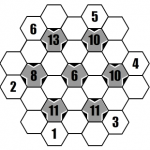 Today’s puzzle is another original puzzle called Number Junctions. I originally named these puzzles Octangles as they contained a collection of octagons. However, when Mindware published them in book form (actually two books), they changed the format to circles and subsequently the name. Number Junctions are easy to understand – all you need to do is to place the given numbers into the small following the simple rules (or directions). In order to correctly solve these puzzles, you will only need to use basic addition and your deductive reasoning skills. Each puzzle is an nxn grid (like 5×5 or 9×9) of circles. Between every group of four circles is a “diamond” containing a number. This number is the sum of the numbers in the four surrounding circles. Finally, each row (and column) contains the numbers 1 through n once and only one (just like Sudoku). You just have to place the numbers correctly into the empty circles
Today’s puzzle is another original puzzle called Number Junctions. I originally named these puzzles Octangles as they contained a collection of octagons. However, when Mindware published them in book form (actually two books), they changed the format to circles and subsequently the name. Number Junctions are easy to understand – all you need to do is to place the given numbers into the small following the simple rules (or directions). In order to correctly solve these puzzles, you will only need to use basic addition and your deductive reasoning skills. Each puzzle is an nxn grid (like 5×5 or 9×9) of circles. Between every group of four circles is a “diamond” containing a number. This number is the sum of the numbers in the four surrounding circles. Finally, each row (and column) contains the numbers 1 through n once and only one (just like Sudoku). You just have to place the numbers correctly into the empty circles
Click here for a detailed set of rules and an example puzzle.
Here is an easier 5×5 Number Junctions puzzles from my second book for you to try.
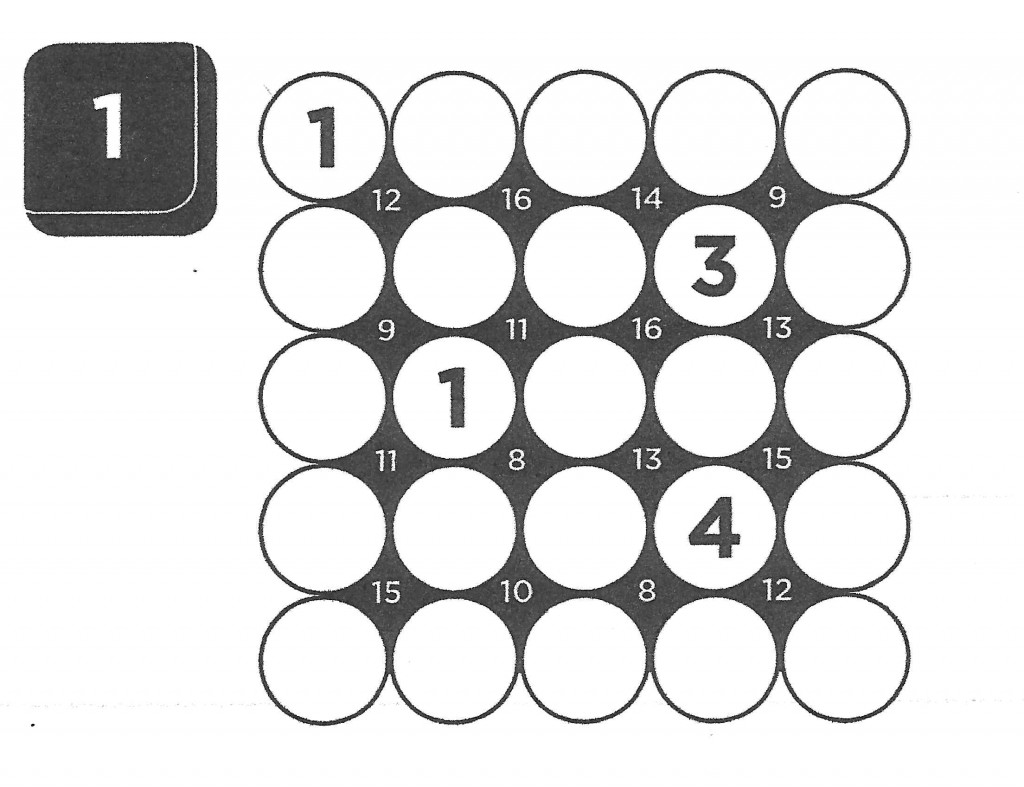
For a more challenge 9×9 Number Junctions puzzle click here!
If you like these Number Junctions puzzles, take a look at the books of Number Junctions that I wrote which is available on mindware. Good Luck and pass the puzzles onto others who may enjoy them!
Number Sense
Holiday Puzzle 2015 #13 – Number Junctions
December 13th, 2015 by John LehetHoliday Puzzle 2015 #11 – Number Circuits
December 11th, 2015 by John Lehet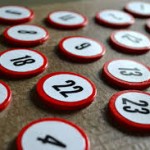
“Today you are you! That is truer than True! There is no one alive that is you-er than you!” – Dr. Suess
Today’s puzzle is another original puzzle called Number Circuits. I originally named these puzzles Magic Puzzles as they are based on Magic Squares. However, when Mindware published them in book form (acually two books), they changed the name. Number Circuits are easy to understand – all you need to do is to place the given numbers into the small circles following the simple rules (or directions). In order to correctly solve these puzzles, you will only need to use basic addition and your deductive reasoning skills.
Here are two Number Circuit puzzles from my second book for you to try – Click here for a pdf file.
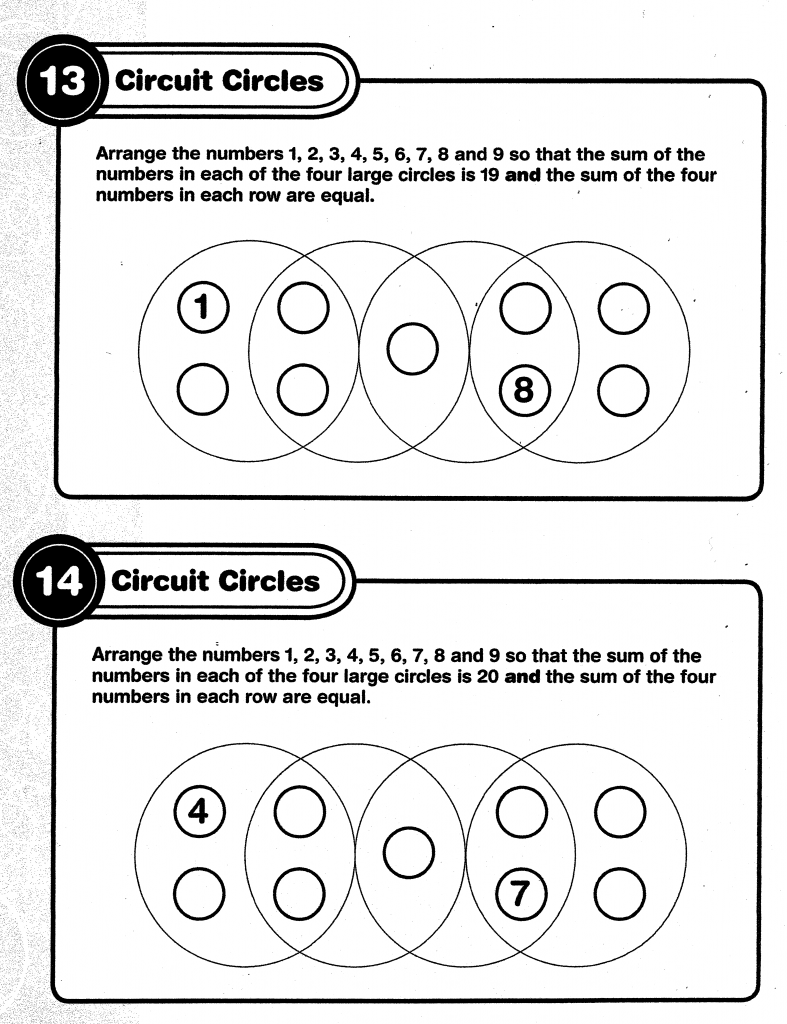
If you like these Number Circuit puzzles, take a look at the books of Number Circuits that I wrote which is available on mindware. Good Luck and pass the puzzles onto others who may enjoy them!
Holiday Puzzle 2015 #10 – Snowflake Puzzles
December 10th, 2015 by John Lehet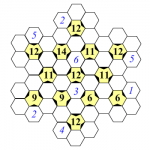
“Begin doing what you want to do now. We are not living in eternity. We have only this moment, sparkling like a star in our hand and melting like a snowflake.” – Francis Bacon
Today’s puzzle is called a Snowflake Puzzle. This is an extension of the Kuruko Puzzles that I created. Like Kurulko puzzles, they are similar to Sudoku puzzles. I call them Snowflake puzzles because of their shape. Snowflakes are symmetric shapes with six points. The Snowflake puzzle follows this design. It is comprised of 42 hexagons (six sided shapes). There are white and yellow hexagons. To complete the puzzle you must fill in each of the empty white hexagons. There are two simple rules to follow:
1. Surrounding each yellow hexagon there are six white hexagons, these must contain the numbers 1 through 6 (each number once and only once)
2. The number in each yellow hexagon is the sum of the numbers in the three white hexagons that point to it (with a black triangle).
Here’s a snowflake puzzle for you to try – Click here for a pdf file.
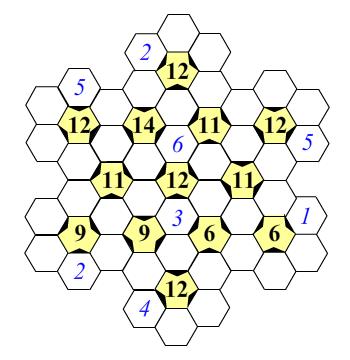
If you like the snowflake puzzle, take a look at the book of 100 Kuruko Puzzles that I wrote which is available on Amazon.com. Good Luck and pass the puzzles onto others who may enjoy them!
Holiday Puzzle 2015 #7 – Hex Codes
December 7th, 2015 by John Lehet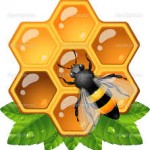
“” –
Today’s puzzles are Hex Codes. Each puzzle is a collection of adjacent hexagons that follow a pattern. Each hexagon contains either a number/letter or is empty. The objective is for you to fill in empty hexagons with the correct number/letter that follows the given pattern. You must determine the pattern that each puzzle exhibits in order to correctly complete each puzzles. The hexagons may vary in color which may be of importance (hint, hint, nudge, nudge). Some of the puzzles may use addition or subtraction, while others may utilize some other connection (like adjacent hexagons or the color) between certain attributes. That’s all for you to figure out. These puzzles can be very challenging.
All you need to do is to figure out the pattern in each puzzle and then use it fill in empty hexagons. Below are four puzzles to try. If you like them, click here for a pdf file with more. Best of luck!
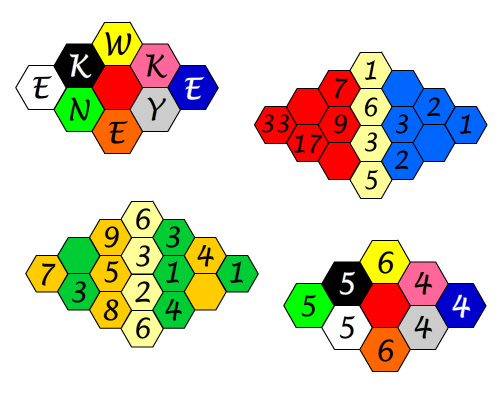
As always, I hope you enjoyed these puzzles. Please pass them onto others who may enjoy them!
Holiday Puzzle 2015 #6 – Kuruko Puzzles
December 6th, 2015 by John LehetToday’s puzzle is an original puzzle idea that I named Kuruko puzzles. (Sounds nearly exotic doesn’t it?) In any case, these puzzles are somewhat like Sudoku puzzles in that you need to fill in empty “boxes” with numbers following a given pattern. In Sudoku, the “boxes” are squares and they are evenly distributed in chess board-like grid. In Kuruko, the “boxes” are hexagons and they are distributed in a hexagonal pattern. Some of the hexagons are gray (7 of them) and some are white (24 of them). Around each gray hexagon there are six white hexagons. Also, three of the six white hexagons surrounding each gray hexagon “point” to the gray hexagon with a black arrow. Just like Sudoku, Kuruko has some very simple rules to follow, actually just two rules:
Rule 1. The number in each gray hexagon is the sum of the numbers in the three white hexagon pointing to it.
Rule 2. Each gray hexagon is surrounded by the numbers 1 through 6 once and only once in each of the six surrounding white hexagons.
Here’s and example puzzle and solution:
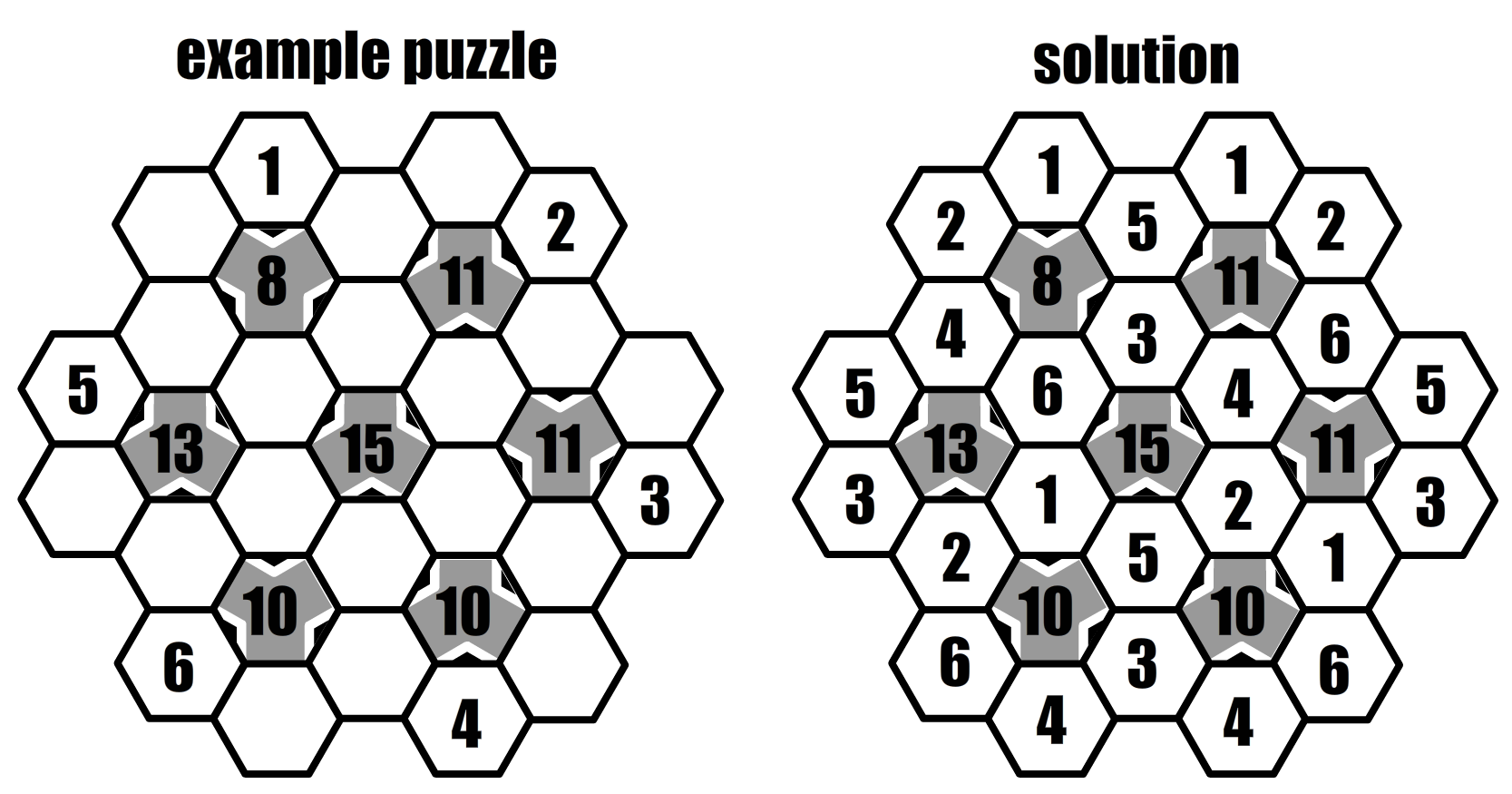
Now for the puzzles. Below are two Kuruko puzzles from my Kuruko puzzle book containing 100 original Kuruko puzzles. Just following the simple rules to solve and Good Luck!

I hope you enjoy these Kuruko puzzles. If you like them, check out my book of 100 Original Kuruko Puzzles available on amazon.com. It’s a great and challenging collection of puzzles. Good Luck and pass the puzzles onto others who may enjoy them!
Holiday Puzzle 2015 #5 – Alphametics
December 5th, 2015 by John Lehet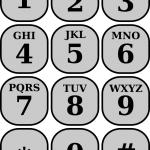
“Believe you can and you’re halfway there.” – Theodore Roosevelt
Today’s puzzle is a great puzzle that everyone can enjoy. They are called alphametics. In each puzzle, there is a simple addition problem. However, instead of using numbers, letters are used. Each letter stands for a single digit number (e.g. 0,1,2,3,4,5,6,7,8 or 9). Within each puzzle, a number can be associated with only one letter, so two different letters can not equal the same number. The meaning of the letters may change from puzzle to puzzle, so “N” may be “5” in the first puzzle and may be “3” in the second puzzle. The objective is to assign each letter a number so the statement is correct – in other words, it all adds up. It sounds straight-forward and is easy to understand, but may be very challenging. Here’s an example:
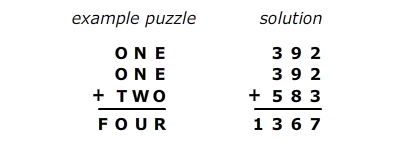
In this example, there are eight different letters each matched with a unique number, so F=1, O=3, U=6, R=7 and so on. Make sure you understand the example. When you do, try the following puzzles. I have created three interactive puzzles below.
The first puzzle has eight unique letters (L,E,T,I,S,N,O,W) with only T duplicated. Use any of the numbers 0 through 9 (two numbers will not be used) to solve. There are numerous solutions. Enter your answer in the boxes and select Check when complete to check your answers.
The second puzzle has eight unique letters (F,O,U,R,N,E,I,V) with F,O,E duplicated. Use any of the numbers 0 through 9 (two numbers will not be used) to solve. There are numerous solutions. An extra challenge is to try to solve this puzzle using only the numbers 0 through 7 (try not to use 8 and 9). Enter your answer in the boxes and select Check when complete to check your answers.
I’ve heard it said that two wrongs don’t make a right, but three lefts do! The third puzzle has eight unique letters (L,E,F,T,R,I,G,H) with L,E,F,T duplicated. Use any of the numbers 0 through 9 (two numbers will not be used) to solve. There are numerous solutions. An extra challenge is to try to solve this puzzle using only the numbers 1 through 8 (try not to use 0 and 9). Enter your answer in the boxes and select Check when complete to check your answers.
I hope you enjoy these puzzles. Good Luck and pass the puzzles onto others who may enjoy them!
Holiday Puzzle 2015 #4 – Number Sense Puzzles
December 4th, 2015 by John Lehet
“Excellence is the gradual result of always striving to do better.” – Pat Riley
Today’s puzzle is a Number Sense Puzzle. They are geared for younger puzzlers to help them improve their number sense. However, many have requested more challenging puzzles, so I have included a second more challenging puzzle for older puzzlers (just click the link below). In each, there are 8 statements each corresponding to a number. You have to use the numbers 0 through 9 once and only once to fill in the correct number for each statement. You will need to use and develop your deductive problem solving skills in order to correctly place the numbers. Since there are only 8 answers and 10 numbers (0 through 9), some of the answers will require two digits.
click here for the more challenging number sense puzzle
I created an interactive puzzle that will automatically check your answers and provide feedback. I also created a pdf file that can be used in classrooms or with pencils for those so inclined. The goal is to have fun and challenge yourself.
select Check when complete to check your answers
I hope you enjoy these puzzles. If you find these interesting, Click Here for a selection of more Number Sense puzzles that I’ve created. I will be adding to the selection over time. Good Luck and pass the puzzles onto others who may enjoy them!
Holiday Puzzle 2015 #3 – Math Riddles
December 3rd, 2015 by John Lehet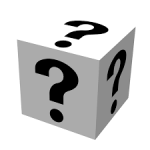
“You can observe a lot by watching.” – Yogi Berra
It’s my favorite today – Math Riddles! These are all original. Some are from my riddle book Riddle-Me Math and some are new. I love riddles because they are often very simple to state, but at the same time, very difficult to solve. There are five riddles below, dealing with numbers and relationships (e.g. proportions). Riddles typically require a bit of thought and their solutions may not be immediately seen. That’s the challange! Don’t give in, keep thinking about them and try to get each solution without being told. Your first few guesses may seem crazy, but keep plugging along – even the best riddlers take their time and make a few mistakes.
1. What is the only number with the same number of letters as its name?
2. What number is half the number of letters as its name? (there are two answers – try to get them both!)
3. What number is equal to five times the number of letters in its name?
4. If a month lasted only an hour, then a year would last how long?
5. If a dime was a year, then what would a dollar be?
I hope you enjoy these riddles. Good Luck and pass the puzzles onto others who may enjoy them!
Tuesday’s Twister #20 – Number Sense (Place Values)
November 6th, 2015 by John LehetHere’s another Number Sense Puzzle. Today’s puzzle centers around another fundamental skill that gives many students a really difficult time – Order of Operations. This is geared to younger puzzlers to help them improve their Order of Operations skills. As always, let me first give a general introduction. There will be 8 statements each corresponding to a number. You have to use the numbers 0 through 9 once and only once to fill in the correct number for each statement. You will need to use and develop your deductive problem solving skills in order to correctly place the numbers. Since there are only 8 answers and 10 numbers (0 through 9), some of the answers will require two digits. In this puzzle, some of the answers will be negative, that’s no problem, just make sure the digits use 0 through 9 once and only once.
I created an interactive puzzle that will automatically check your answer and provide feedback. I also created a pdf file that can be used in classrooms or with pencils for those so inclined. The goal is to have fun and challenge yourself.
select Check when complete to check your answers
I hope you enjoy these puzzles. If you find these interesting, Click Here for a selection of more Number Sense puzzles that I’ve created. I will be adding to the selection over time. Good Luck and pass the puzzles onto others who may enjoy them!
Tuesday’s Twister #19 – Number Circuit Puzzles
November 3rd, 2015 by John Lehet 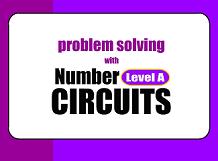 In November and December each year I make classroom presentations for elementary schools. One of my presentations is on Problem Solving. I am a big believer that puzzles are a great way to introduce and improve problem solving skills. I use my original Number Circuit puzzles. I have developed a complete Lesson Plan and Teacher’s Guide to complement my presentation. I essentially break problem solving down into five steps:
In November and December each year I make classroom presentations for elementary schools. One of my presentations is on Problem Solving. I am a big believer that puzzles are a great way to introduce and improve problem solving skills. I use my original Number Circuit puzzles. I have developed a complete Lesson Plan and Teacher’s Guide to complement my presentation. I essentially break problem solving down into five steps:
1. Read The Problem
2. What Do I Know? (a question all problem solvers should ask)
3. What Am I Looking For? (another question that must be answered)
4. What Can I Conclude? (This is the tough one!)
5. Solve The Problem
Too often I see children jump right to step 5 and try to solve the puzzle (or problem) without doing all or even any of the preliminary steps. Although skipping steps is sometimes faster, it is all too often unsuccessful. Go Fast Slowly is what I tell them. Take your time. Speed is not important. However, getting the correct answer and improving are both REALLY important! Please take a look at the supporting materials and give the puzzles a try. Remember it’s about having fun and getting better at the same time!
or
click here for an Interactive Lesson Plan using Number Circuit Puzzles
Below is a collection of six interactive Number Circuit puzzles for you to try!
I hope you enjoy these puzzles. If you find these interesting, Click Here to view our complete collection of puzzle books. Good Luck and pass the puzzles onto others who may enjoy them!


